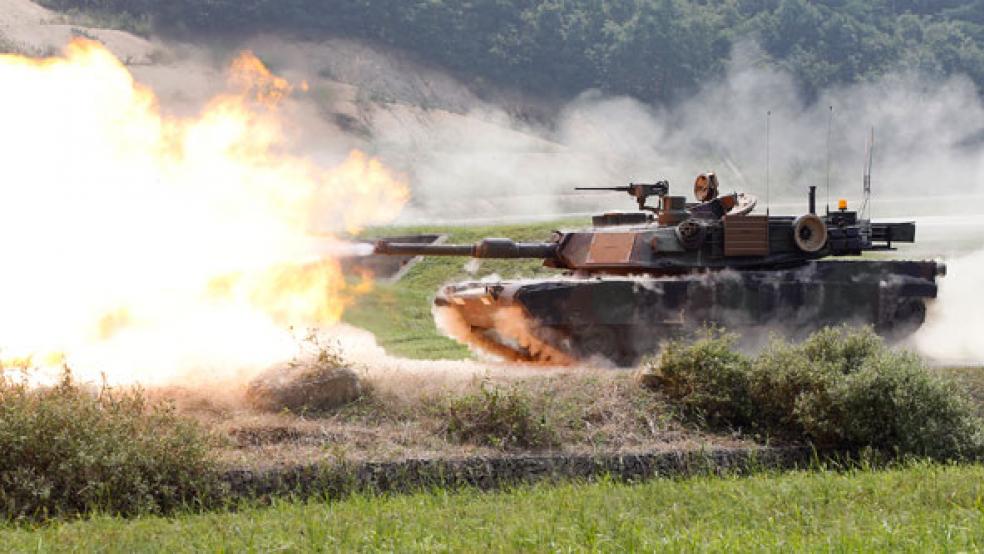There’s too much slush in the supplemental, as shown by the fourfold jump in spending per deployed service member.
The heads of the armed services committees in the House and the Senate have called on President Obama to submit a supplemental budget request to cover the costs of deploying 560 additional troops to Iraq. The chairs, Rep. Mac Thornberry, R-Texas, and Sen. John McCain, R-Ariz., have also pointed to the president’s decision to slow down the withdrawal of troops from Afghanistan as a reason to increase war spending.
Related: How the Air Force Would Use the F-35 in a Conflict With China
If every dollar in the current war budget were being spent as intended, Thornberry and McCain might have a point. But this is manifestly not the case. Over the past decade, the president and the Congress have spent tens of billions of dollars from the war fund – officially known as the Overseas Contingency Operations (OCO) account – on equipment and activities that have nothing to do with fighting wars. OCO has become a slush fund to pay for projects that don’t fit under the caps on the Pentagon’s base budget that are part of current law. If OCO were used properly, there would be plenty of funding available to pay for the president’s shifts in troop deployments in Iraq and Afghanistan.
A Congressional Research Service report estimates that at least $71 billion in non-war costs had been placed in the OCO budget through the end of fiscal 2014. This is a conservative estimate. If anything, abuse of the war fund to pay for unrelated items has grown in recent years.
One measure of how much slush there may be in the war budget is the ratio of troops deployed in Iraq and Afghanistan to the size of the OCO account. When the Obama administration took office, there were 184,000 troops deployed in Iraq and Afghanistan, and the war budget was $145.7 billion. Under this year’s proposal, even allowing for the president’s changes in proposed troop levels in Iraq and Afghanistan, the number of troops deployed will be 13,697, while the war budget is slated to come in at $58.8 billion. That’s a more than a fourfold change in costs, from less than $1 million per troop in 2009 to well over $4 million per troop now.
This steep increase cannot be explained away by looking at the costs of destroying or returning excess equipment, “resetting” the force to replace equipment destroyed or damaged in the wars, or even the questionable decision to expand the geographical areas that the war account is applied to. Nor can it be accounted for by the costs of new items like the Counterterrorism Partnership Fund, which at a proposed $1.1 billion is less than two per cent of the war budget. The primary explanation for such a large change is that much of the current OCO proposal bears no relationship to war costs.
Related: America’s High-Tech F-35 Is Poised to Purge ISIS from 30,000 Feet
This brings us to the question of why the Pentagon is throwing such a large portion of its basic costs into the war budget. It is obviously a ploy to evade the caps on its base budget, since the base budget is capped under current law while the OCO budget is not. But is this maneuver necessary to pay for essential costs that can’t be accommodated under the caps? The answer is no.
As a recent letter from 17 good-government groups from across the political spectrum has argued, there is at least $38.6 billion in the current Pentagon budget proposal that could be eliminated without undermining our security. These items include pausing the troubled Littoral Combat Ship (LCS) program; cutting funds for the overpriced, underperforming F-35 combat aircraft; ending plans to build a new nuclear-armed cruise missile; and eliminating private contractors who are doing work that could be handled by government employees. Making these changes would leave plenty of funding to pay for the Pentagon’s ongoing costs without raiding the war budget. That in turn would free up funds that could more than cover any additional costs resulting from President Obama’s troop shifts in Iraq and Afghanistan.
The Senate Appropriations Committee has also demonstrated that the size and composition of the Pentagon’s current base budget is not sacrosanct. The committee came up with $15 billion in savings from the Pentagon’s proposed 2017 budget. Unfortunately, the committee chose to turn around and allocate some of those funds to unnecessary items like additional F-35s that the Pentagon hasn’t even requested. But regardless how it chose to use the freed-up funds, the committee showed that there are savings to be had from the Pentagon’s current proposed budget.
Before they request more funds for the war budget, Congressional leaders should get their own budgetary house in order. We don’t need more Pentagon spending. We need more spending discipline.
William D. Hartung is the director of the Arms and Security Project at the Center for International Policy.
This article was published originally in Defense One. Read more at Defense One:




